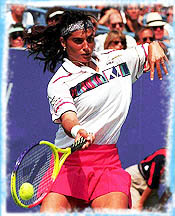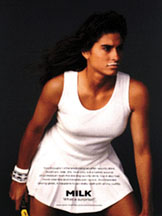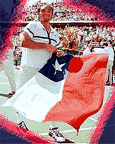


Tennis in Latin America



Professional tennis players are celebrities who earn millions of dollars a year in prize money and commercial endorsements, and are pursued by paparazzi everywhere they go. Latin America has produced a number of tennis stars. In this report, we will discuss the status of tennis as a participatory sport as well as a spectator sport.
Although the origin of the game of tennis is not completely certain, most people credit the invention of the game to the British official Major Walter Clopton Wingfield in Bermuda. Today, this game is popular in many parts of the world. In theory, the game of tennis is simple enough --- the singles game is played by two person on a tennis court, whence they play by hitting a tennis ball across a net to the other person with a tennis racket. The game cannot be played easily except with standard equipment and courts. Players are accustomed to playing with these standards, and it is disadvantageous to encounter non-standard conditions.
Here are the specifications for the tennis court:
The Court shall be a rectangle 78 feet (23.77m.) long and 27 feet (8.23m.) wide. It shall be divided across the middle by a net suspended from a cord or metal cable of a maximum diameter of one-third of an inch (0.8cm.), the ends of which shall be attached to, or pass over, the tops of two posts, which shall be not more than 6 inches (15cm.) square or 6 inches (15cm.) in diameter. These posts shall not be higher than 1 inch (2.5cm.) above the top of the net cord. The centers of the posts shall be 3 feet (.914m.) outside the Court on each side and the height of the posts shall be such that the top of the cord or metal cable shall be 3 feet 6 inches (1.07m.) above the ground.
The net shall be extended fully so that it fills completely the space between the two posts and shall be of sufficiently small mesh to prevent the ball passing through. The height of the net shall be 3 feet (.914m.) at the center, where it shall be held down taut by a strap not more than 2 inches (5cm.) wide and completely white in color. There shall be a band covering the cord or metal cable and the top of the net of not less than 2 inches (5cm.) nor more than 21/2 inches (6.35cm.) in depth on each side and completely white in color.
The lines bounding the ends and sides of the Court shall respectively be called the base-lines and the side-lines. On each side of the net, at a distance of 21 feet (6.40m.) from it and parallel with it, shall be drawn the service-lines. The space on each side of the net between the service-line and the side-lines shall be divided into two equal parts called the service-courts by the center service-line, which must be 2 inches (5cm.) in width, drawn half-way between, and parallel with, the side-lines.
Having the right tennis racket can also make a big difference in the game. The modern tennis game is also regarded as having been qualitatively different from the game years ago due to the introduction of the new rackets that allow players to serve at 150 miles per hour. Here are the specifications for the tennis racket:
The hitting surface of the racket shall be flat and consist of a pattern of crossed strings connected to a frame and alternately interlaced or bonded where they cross; and the stringing pattern shall be generally uniform, and in particular not less dense in the center than in any other area. The racket shall be designed and strung such that the playing characteristics are identical on both faces. The strings shall be free of attached objects and protrusions other than those utilized solely and specifically to limit or prevent wear and tear or vibration and which are reasonable in size and placement for such purposes.
For professional play, the frame of the racket shall not exceed 29 inches (73.66cm.) in overall length, including the handle, as from 1st January 1997. For non-professional play, the frame of the racket shall not exceed 29 inches (73.66cm.) in overall length, including the handle, as from 1st January 2000. Until 1st January 2000, the maximum length of a racket for non-professional play shall be 32 inches (81.28cm). The frame of the racket shall not exceed 121/2 inches (31.75cm.) in overall width. The strung surface shall not exceed 151/2 inches (39.37cm.) in overall length, and 111/2 inches (29.21cm.) in overall width.
Tennis balls are also required to meet specifications, since the design can make a tremendous difference in the responsiveness and behavior of the balls. Here are the specifications of the tennis ball:
The ball shall have a uniform outer surface consisting of a fabric cover and shall be white or yellow in color. If there are any seams they shall be stitchless. The ball shall be more than two ounces (56.7 grams) and less than two and one-sixteenth ounces (58.5 grams) in weight. The ball shall have a bound of more than 53 inches (134.62cm.) and less than 58 inches (147.32cm.) when dropped 100 inches (254.00cm.) upon a concrete base.
The ball shall have a forward deformation of more than .220 of an inch (.559cm.) and less than .290 of an inch (.737cm.) and a return deformation of more than .315 of an inch (.800cm.) and less than .425 of an inch (1.080cm.) at 18 lb. (8.165kg.) load. The two deformation figures shall be the averages of three individual readings along three axes of the ball and no two individual readings shall differ by more than .030 of an inch (.076cm.) in each case.
We enumerated the requirements for the tennis game to show that this game has some stringent requirements, unlike soccer or baseball which can be played anytime anywhere with anything handy. Tennis players must purchase tennis rackets and obtain a supply of tennis balls, with an advantage accruing to players with better rackets (other things being equal). They must find a tennis court, which may be few and expensive to rent either at hourly rates or requiring membership at a club. In other words, tennis may not be a game for everyone. Of course, the odds are very long to become a successful professional player, requiring not only natural talent but substantial investments in time and money at training academies.
We will now cite some data from the 1999-2000 TGI Latina survey. For our purposes here, the database consists of 43,536 respondents in six Latin American countries --- Argentina, Brazil, Chile, Colombia, Mexico and Peru. Here are the bottom line numbers for the sport of tennis
With numbers like these, tennis is definitely not a mass participation sport in Latin America. Nor could it be called a large spectator sport. In the next table, we show the demographic breakdown. Given the expenses associated with learning and playing the game, the popularity of tennis is a monotonic function of socio-economic level. It is also more popular with males and younger people.
| Geodemographic Characteristic | % Seen tennis on TV | % Watched tennis live | % Played tennis |
| Country Argentina Brazil Chile (Santiago only) Colombia Mexico Peru (Lima only) |
12.6% 14.8% 41.8% 14.9% 5.2% 13.9% |
1.1% 0.2% 1.6% 1.0% 0.4% 0.8% |
1.1% 0.3% 4.9% 0.8% 2.1% 3.1% |
| Sex/Age Male 12-19 Male 20-24 Male 25-34 Male 35-44 Male 45-54 Male 55-64 Female 12-19 Female 20-24 Female 25-34 Female 35-44 Female 45-54 Female 55-64 |
14.4% 16.7% 17.2% 15.0% 14.4% 11.6% 12.8% 11.1% 9.5% 10.8% 9.9% 8.4% |
0.7% 0.7% 0.9% 0.4% 0.3% 0.3% 0.6% 0.6% 0.4% 0.3% 0.2% 0.2% |
2.4% 1.8% 1.0% 0.9% 1.2% 0.7% 1.4% 1.1% 0.5% 0.8% 0.5% 0.3% |
| Socio-economic
Level A (top 10%) B (next 20%) C (next 30%) D (next 40%) |
23.5% 16.2% 12.9% 8.4% |
0.9% 0.7% 0.5% 0.3% |
2.8% 1.6% 1.0% 0.4% |
| TOTAL | 12.8% | 0.5% | 1.1% |
(Source: TGI Latina)
  |
The number that really stands
out in the above table is the incidence of television viewers of tennis in
Chile. This is a tribute to the popularity of the ranked
professional player from Chile --- Marcelo "Chino" Rios.
At one time, Rios was ranked the number one player in the world. Not
the most powerful or elegant player, Rios is a persistent battler.
His tournament games are broadcast on prime time television in Chile to
high ratings, as Chileans obviously enjoy the sight of one of their own on
the world stage. He may not have won the
tournament and one may not actually learn who that winner is, but one would have
watched Rios played his heart out. The long-term future of the game
in Chile cannot depend on a single charismatic figure. But by virtue
of his success, Rios has inspired more Chileans to take up attending and
playing tennis. |
| Gustavo "Guga" Kuerten is a top-ranked professional player from Brazil with a great deal of flair and charisma. Guga won the French Open in 1997 and 2000. The data here indicate that Kuerten's influence on the state of the sport in Brazil is not as strong as Rios in Chile. |
|
![]()
WWW TENNIS SITES
WWW LINKS TO TENNIS ORGANIZATIONS
WWW LINKS TO LATIN AMERICAN TENNIS PLAYERS
(posted by Roland Soong on 9/01/00)
(Return to Zona Latina's Home Page)